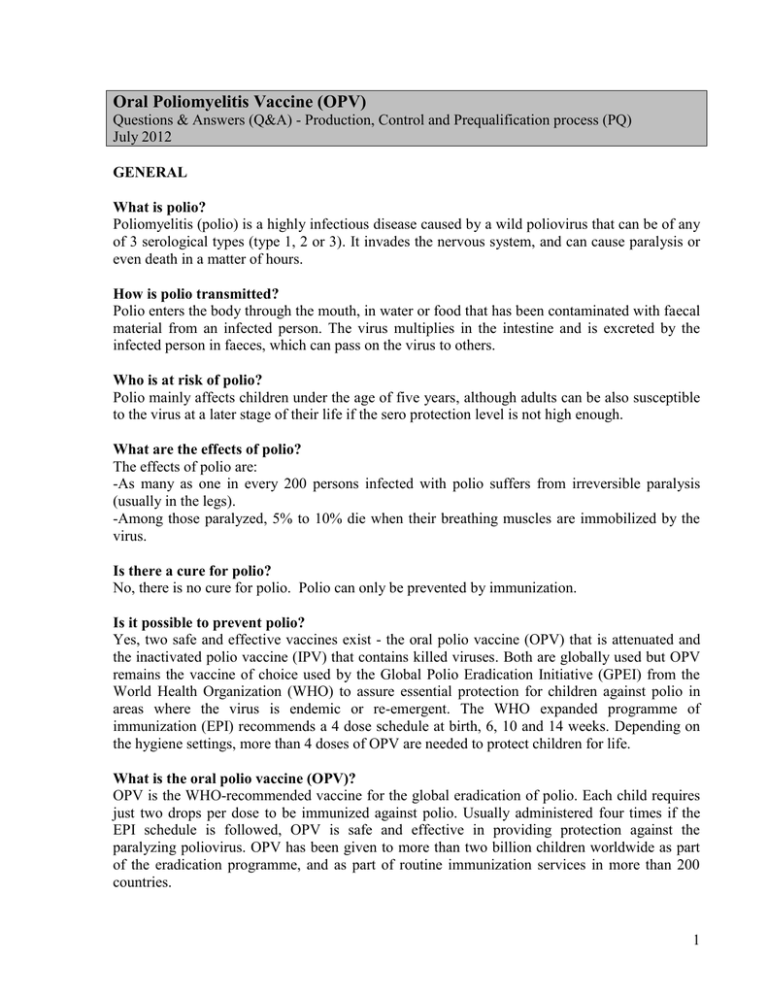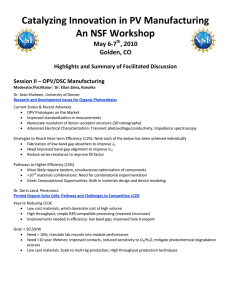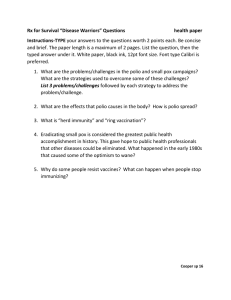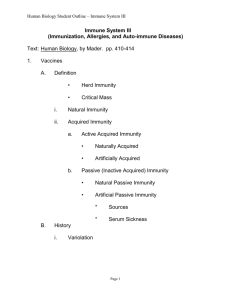Oral Poliomyelitis Vaccine (OPV)
advertisement

Oral Poliomyelitis Vaccine (OPV) Questions & Answers (Q&A) - Production, Control and Prequalification process (PQ) July 2012 GENERAL What is polio? Poliomyelitis (polio) is a highly infectious disease caused by a wild poliovirus that can be of any of 3 serological types (type 1, 2 or 3). It invades the nervous system, and can cause paralysis or even death in a matter of hours. How is polio transmitted? Polio enters the body through the mouth, in water or food that has been contaminated with faecal material from an infected person. The virus multiplies in the intestine and is excreted by the infected person in faeces, which can pass on the virus to others. Who is at risk of polio? Polio mainly affects children under the age of five years, although adults can be also susceptible to the virus at a later stage of their life if the sero protection level is not high enough. What are the effects of polio? The effects of polio are: -As many as one in every 200 persons infected with polio suffers from irreversible paralysis (usually in the legs). -Among those paralyzed, 5% to 10% die when their breathing muscles are immobilized by the virus. Is there a cure for polio? No, there is no cure for polio. Polio can only be prevented by immunization. Is it possible to prevent polio? Yes, two safe and effective vaccines exist - the oral polio vaccine (OPV) that is attenuated and the inactivated polio vaccine (IPV) that contains killed viruses. Both are globally used but OPV remains the vaccine of choice used by the Global Polio Eradication Initiative (GPEI) from the World Health Organization (WHO) to assure essential protection for children against polio in areas where the virus is endemic or re-emergent. The WHO expanded programme of immunization (EPI) recommends a 4 dose schedule at birth, 6, 10 and 14 weeks. Depending on the hygiene settings, more than 4 doses of OPV are needed to protect children for life. What is the oral polio vaccine (OPV)? OPV is the WHO-recommended vaccine for the global eradication of polio. Each child requires just two drops per dose to be immunized against polio. Usually administered four times if the EPI schedule is followed, OPV is safe and effective in providing protection against the paralyzing poliovirus. OPV has been given to more than two billion children worldwide as part of the eradication programme, and as part of routine immunization services in more than 200 countries. 1 How many times must OPV be given before children are fully immunized against polio? Usually, after four doses of OPV, a child should be protected against polio. However, in conditions that favour the poliovirus spread (i.e. hot weather, poor sanitary and hygienic standards), it may take additional doses of polio vaccine for a child to be completely protected. Therefore, even fully immunized children should be immunized during National Immunization Days. Is it safe to administer multiple doses of OPV to children? Yes, it is safe to administer 4 or more doses of OPV to children. The vaccine is designed to be administered multiple times to ensure full protection. In the tropics where the weather is hot, more than 4 doses of OPV are required for a child to be fully protected – sometimes more than ten are administered without side effects. Each additional dose further strengthens a child’s immunity level against polio. Is there any risk of overdose in case of multiple vaccination? There is no risk of overdose, fully immunized children receiving extra doses of OPV will receive extra protection against polio. The vaccine is administered multiple times to ensure full protection. There is minimal risk of adverse effects from OPV. Is OPV safe for sick children and newborns? Yes. OPV is safe to be given to sick children. In fact it is particularly critical that sick children and newborn babies are immunized because their immunity levels are lower than those of other children. All sick children and newborns should be immunized during the polio campaigns to give them the protection against polio that they desperately need. Does OPV have any side effects? OPV is safe, effective and is the essential tool available to protect all children against polio. It has no common side effects and has been used all over the world to protect children against polio. Over the last 20 years, this vaccine has saved 5 million people from permanent paralysis by polio. On very rare occasions, the live, attenuated (weakened) vaccine-virus can cause paralytic polio cases. But this is an extremely small risk (it only occurs in approximately 1 in every 2.5 million doses administered; this risk applies primarily to the first dose of vaccine administered, and is reduced to virtually zero on subsequent doses). Children are in far greater danger from the circulating polioviruses than from any adverse effects from the polio vaccine. What is the effect of immunization? OPV is highly effective in preventing natural poliovirus-induced poliomyelitis. The oral poliovirus vaccine stimulates the immune system to produce anti-poliovirus antibodies against poliovirus types 1, 2, and 3. The live virus persists in the intestine of receiving children for 4-6 weeks, inducing both mucosal and serum anti-poliovirus antibodies capable of neutralizing wild poliovirus. How many different OPV vaccines are available? The trivalent vaccine (tOPV) is used in many countries for both routine or supplemental vaccination. Monovalent OPVs, against type 1 (mOPV1) and against type 3 (mOPV3) and bivalent OPV against type 1 and type 3 (bOPV) are also available and used by the Global Polio 2 Eradication Initiative; they have been licensed for use in endemic countries or for outbreak control in situations where one or two types can re-emerge. Monovalent OPV against type 2 has been licensed, but is expected to be used primarily for emergency response stockpiles. Why are some industrialized countries using a different vaccine for polio than developing countries? The vast majority of developed countries in the world used OPV to eliminate polio and continued using OPV, some until the late 1990s, when they switched to inactivated polio vaccine because of decreasing risk of importations, due to progress towards polio eradication. To date most countries (about 150 out of 193) still use OPV as it has a unique ability to induce intestinal, local immunity which can actually interrupt wild poliovirus transmission in the environment. This is not possible with IPV, an inactivated polio vaccine, which induces only very low levels of immunity to poliovirus inside the gut, and as a result provides individual protection against polio, but unlike OPV, cannot prevent the spread of wild poliovirus. In the near future, IPV might be introduced in sequential schedule after 2 or 3 doses of OPV to fill the immunity gap observed in the children below 5 and therefore play a role in the eradication endgame. PRODUCTION What is the composition of OPV? The composition of OPV includes water, culture media, stabilizing agents, traces of antibiotics and attenuated (Sabin) strains of poliovirus. How is OPV manufactured? OPV is manufactured by infecting cells with an attenuated (weakened) poliovirus. A variety of cell lines are used, depending on the manufacturer and manufacturing process. The mainstay for the production process has been to use monkey kidney cells. Other production processes of OPV use human diploid cells. What are the producing cells used for OPV? The cell lines used in the manufacturing of OPV have remained the same since production of OPV started in the 1950s. They are fully characterized by the manufacturers and well known by regulatory and health authorities around the world, as well as by producers. These cell lines are used only for poliovirus growth - the harvested poliovirus is then washed and cleansed before it is inserted into the final OPV product. Does OPV contain anti-fertility agents (e.g. synthetic oestrogens)? OPV does not include any anti-fertility agents during the production process. Therefore, testing of OPV for anti-fertility agents is not required or recommended by international and national vaccine production or regulatory guidelines, and is not part of the routine tests that are performed on OPV for control of the quality and safety. Does OPV contain any other pathogen/contaminant? No agents which may cause infectious, malignant, or other diseases, such as HIV or SIV, are present during the production of OPV nor are such agents present in the finished product. The 3 absence of such agents is guaranteed through adherence to strict quality control procedures, extensive testing during the production of the vaccine, and the independent review of all relevant tests by national regulatory agencies prior to release of each batch of vaccine. CONTROL Is the quality, efficacy and safety of OPV guaranteed? All vaccines, including OPV, that are procured by United Nations agencies such as PAHO and UNICEF must meet specific criteria set by the Expert Committee on Biological Standardization (ECBS). These criteria govern the exact contents used in the production of OPV and ensure that the purity of the vaccine meets the expectations. Specifications established for production and control of OPV are described in the Technical Report Series 904 and 910 posted on the WHO Biologicals website at: http://www.who.int/biologicals/technical_report_series/en/index.html How can WHO ensure quality, efficacy and safety of OPV? To ensure that vaccines procured by UN agencies meet these specifications, WHO verifies compliance with good manufacturing practices (GMP) and ensures a system of quality assurance and strict controls are in place. These mechanisms, known as WHO ‘prequalification’ of vaccines, are designed to guarantee that the manufacture of OPV used in the Global Polio Eradication Initiative meets international ECBS specifications. All OPV procured by United Nations agencies for polio eradication campaigns comes from manufacturers who have been prequalified by WHO for the production of this specific vaccine. Each batch of OPV undergoes full testing by the manufacturer, and the test results are reviewed by the National Regulatory Authority for biological substances (NRA) of the country where the OPV is produced, prior to its release. In addition, the National Control Laboratory conducts a battery of tests on randomly selected batches. PREQUALIFICATION What is WHO's prequalification programme and what checks are in place to ensure continued compliance to international standards of quality, safety and efficacy? Set up over 20 years ago, WHO's "seal of approval" (prequalification) is a mechanism to ensure that all countries across the world have access to vaccines of assured and comparable high quality. Each application for prequalification of a vaccine is independently and rigorously undertaken. The process includes: scrutiny of information on production methods, vaccine composition, quality control and clinical evaluation by a WHO team of experts; independent consistency testing by WHO-qualified laboratories; site audits of manufacturing facilities. 4 Is the “prequalification” status continuously monitored? WHO monitors the performance of UN supplied vaccines in the field on a continuing basis. This monitoring includes testing of vaccine lots used in the field, review of complaints received from users and investigation of reports of adverse events following immunization. In addition, WHO reviews, on an annual basis, updated information submitted by manufacturers regarding performance of their vaccine in other markets as well as any changes introduced in the production or quality control methods. Full reassessments of prequalified products (similar to the initial evaluation review) are undertaken by WHO-convened teams at regular intervals (frequency depends on performance monitoring conducted by WHO). Site audits to the manufacturing facilities can be triggered at any time if the outcome of the post-prequalification monitoring is not satisfactory. How does WHO cooperate with the National Regulatory Authorities? A key component of WHO's work to ensure the safety and quality of vaccines used across the world is the strengthening of national regulatory authorities, because the prequalification assessment procedure established by WHO requires a functional National Regulatory Authority (NRA) in the country of manufacture. In the prequalification programme strong collaboration with each National Regulatory Authority (NRA) is established. WHO relies on the continuing oversight of the prequalified vaccines by the responsible NRA. These authorities perform the control and release of each batch of OPV, ensure a detailed review of production process and quality control methods, and verify production consistency through inspection of manufacturing sites at regular intervals. These procedures are further supported through random testing of vaccines by WHO-contracted laboratories which ensure compliance with WHO requirements and tender specifications on a continuing basis. Is WHO providing support to countries not capable of controlling vaccines on their own? All prequalified vaccines can be supplied to countries through United Nations agencies or procured directly by countries. Countries which do not have the ability to conduct their own checks of vaccine quality rely on WHO prequalification to guide their vaccine purchasing choices. WHO contact person Dr Jackie Fournier-Caruana, Quality, Safety and Standards 5



